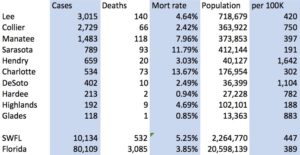
More than 10,000 people tested positive for COVID-19 in Southwest Florida since Florida’s first case was reported there March 1.
From a Manatee County patient that became the first reported coronavirus case in Florida to a Lee County woman who became the first American on the U.S. East Coast to die from COVID-19, the pandemic has been a harsh presence in the region.
There has never been an outbreak on the scale seen in South Florida counties Miami-Dade, Broward and Palm Beach. But whether because of Southwest Florida’s age demographics or proximity to infected areas, there has been an outsized presence of the coronavirus even compared to more densely populated areas of the state.
About 1 in 8 Florida cases of COVID-19 have come from the region, and 1 in 6 Florida deaths occurred there.
Lee County, the most populous in the 10-county region, has now passed 3,000 confirmed cases of COVID-19, following 147 positive cases for residents that came back Monday. There were 383 cases reported in a three–day period. The median age for patients there has been 56, about 10 years older than statewide figures.
As on Tuesday, Lee Health reported that 131 COVID-19 patients were currently in the health care system’s hospitals. That’s about 11% of all beds in the system. The system still has about 22% of beds unfilled, and about 28% of ICU rooms available for use. About 69% of ventilators in the hospital group’s inventory remain unused.
The Department of Health reports 784 of the 3,015 patients since the start of the pandemic have been age 65 or older. But while the county at one point had one of the highest mortality rates in Florida, that has since subsided substantially.
In both Charlotte and Sarasota counties, more than 1 in 10 individuals who tested positive for COVID-19 have died. In Charlotte County, 101 of the 534 cases of infection have been in patients age 85 or older, contributing to the higher level of risk facing patients there.
Manatee County joins Lee as the only other county with more than 100 recorded deaths from COVID-19.
But Collier County, which shares a border with Miami-Dade, has seen a substantial climb in recent weeks in the number of infections. Since the beginning of the pandemic, the region has seen 2,729 individuals test positive and 66 of those die.
County Commissioner Bill McDaniel said much of the increase in case load has come as health officials reached further into underserved areas like Immokalee. There’s been growing concern about the spread of the virus in migrant communities. McDaniel reiterated those, noting many workers get paid by the day and have no sick time, and are likely to hop into a packed bus of workers even after testing positive.
“There are enormous barriers we are having to overcome in this community,” he said. “Language barriers, income barriers, culture barriers, housing barriers, documentation barriers. You add all those up and you are going to have a higher positive count.”
But he stressed hospital networks in the region, both in Collier and Lee, remain capable of handling the expected case loads at the current infection rates.
Some greater concerns may exist in more rural communities like Hendry County. While that low-density community has the youngest median age of any county in Florida, there has been a recent spike in cases of COVID-19 positive tests.
At this point, the infection rate per 100,000 people in Hendry is greater than 1,600, a rate double that of Miami-Dade County. The 659 patients in a county of just over 40,000 people means 1.6% of the population has been diagnosed with the disease.




